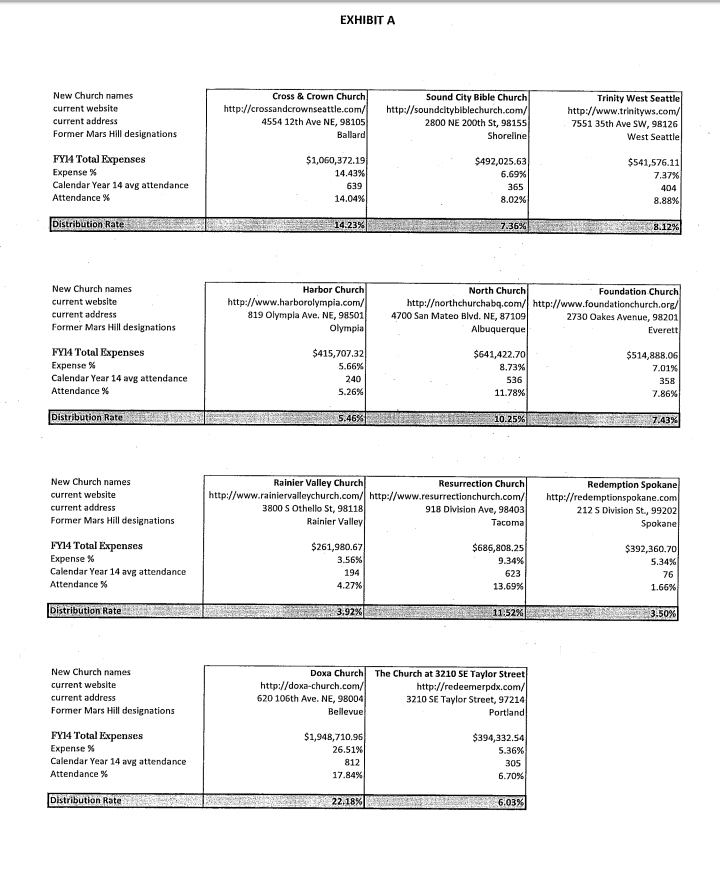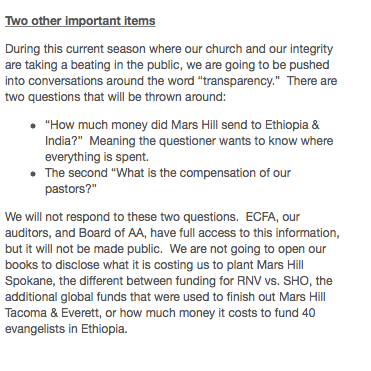Sutton Turner provides his side of the Mars Hill Global story in a lengthy blog post today.
The omission of financial information is puzzling. For instance, Turner says:
In 2014 alone, Mars Hill gave $X to support efforts in Ethiopia and India. This is over X times what was given toward all non-US church planting from 2009-2011.* See the quote below from the Mars Hill Church FAQ web page in 2014**:
He addresses the confusion surrounding messaging on Global and honored the request of attorneys to leave out specific dollar amount given to international missions. Even though there is potential for legal action, it is hard to understand why these numbers are not provided. Turner says:
*Unfortunately, Mars Hill’s attorneys have requested that I not blog. I have removed some of the financial information as well as other non-financial information in response to their request.
Even though Mars Hill is a church, the attorneys are ruling the situation. The amount of money a church gives to missions is a secret? This is ridiculous, especially in absence of some compelling explanation.
Regarding the intent of the Mars Hill Global program, I have a hard time with these paragraphs:
Over the last twelve months, many have criticized the intentions and practices surrounding Mars Hill Global. This criticism focused around the claim that the leadership of Mars Hill confused donors who were giving to the Global Fund leading them to believe that 100% of all donations to Mars Hill Global went to Ethiopia and India.
I am sorry that some who contributed to Mars Hill Global (as well as those who did not contribute) were mistakenly led to believe incorrect information.That was neither my nor the church’s intention, but as the accusations came in, we quickly made a change on the online giving site to remove the term “Global Fund” (which had been used since 2009) to make it clearer. Secondly, we had the Evangelical Council for Financial Accountability (ECFA), as well as an external, independent auditor, conduct thorough investigations. Both of these groups found that we could have been clearer during our communications (and in hindsight, we certainly agreed), but they reported that we did nothing wrong. Although neither the ECFA nor the auditor gave us any course of corrective action, my leadership team and I wanted to do everything we could to remedy the situation and correct our mistakes.
Turner did not deal with this memo which seems to suggest that there was a plan to misinform donors. For instance, the amount of money was not to be disclosed to the public (still not happening):
Flagship Projects
Of the money that comes into the Global Fund, designate a fixed percentage internally for highly visible, marketable projects such as mission trips, orphan care, support for pastors and missionaries in the third world, etc. (ten to fifteen strategic operations in locations where Mars Hill wants to be long term). This percentage should be flexible (not a “tithe”), and not communicated to the public. Support for Mars Hill Global would be support for Mars Hill Church in general, but the difference and the draw would be that a portion of Global gifts would also benefit projects that spread the gospel and serve the needs of people around the world.
And then there was this paragraph:
The Global Fund could be beneficial in a number of ways, besides the obvious gain of increased funding:
• For a relatively low cost (e.g. $10K/month), supporting a few missionaries and benevolence projects would serve to deflect criticism, increase goodwill, and create opportunities to influence and learn from other ministries.
The plan at some point in re-launching Global was to support missions but to do so in a way that brought in more money than the mission support required. Again, read the entire re-launch memo; somebody had intent to play up missions and reap a harvest for U.S. expansion.
I was glad that Turner disclosed that the ECFA was involved. That they required nothing of Mars Hill is a loud clear testimony that they are not in business for donors. I may write a separate post about this disclosure.
Overall, I appreciate Turner’s disclosures. He acknowledges mistakes and says he was responsible:
I now realize that over time, I did not continue to communicate as well as I should have that Mars Hill Global was doing church planting in the US, Ethiopia, and India. My personal passion for Ethiopia began to overtake the communication about church planting in the US.
My personal passion for Ethiopia began to overtake the communication about church planting in the US.
I also made a very bad assumption that because the last decade of Mars Hill had been acutely focused on church planting in the US with Acts29, that I needed to focus more on what we were doing outside of the US. I assumed that everyone knew our church planting efforts in the US were continuing (which they did—with seven more churches between 2012 and 2014.)
I am deeply sorry for any confusion caused by my and my former team’s communications. Although this was certainly not our intention, the outcome still remains and we did everything in our power to rectify this error with Global donors in the summer of 2014. I understand that this situation has hurt some people’s (both Christian and non-Christian) trust in church stewardship for the larger church in general, and I am deeply saddened by this. Again, I am very sorry; I should have better communicated the goals, the use of funds, and the future vision of Mars Hill Global in the United States and wherever God would lead us in the world.
In this post, Turner makes another stunning admission:
Mistakes. When you make a mistake, admit it clearly and quickly. As I have mentioned previously, the MH BOAA discussed many different paths for communication, including trying to get ahead of the story and remaining silent. Unfortunately, we made the mistake of assuming that if we were silent about this issue it would pass over.
Mars Hill (along with the ECFA) hoped the matter would go away. The ECFA continues to take this approach when asked questions about their dealings. In some cases, it probably does work. It has worked so far for David Jeremiah but doesn’t always work as in the case of Mars Hill.
All in all Turner has shed some light on the Mars Hill Global story. Although there are more questions (e.g., who told Justin Dean to make up that elaborate story about the Global Fund not being a fund?), Turner’s admission point us to a little more clarity. If only the lawyers would understand what kind of organization they work for.


